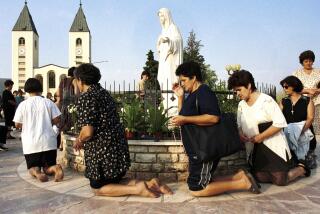He Sends the Devil Packing
- Share via
ROME — In a small room, well away from the street so that no one hears the screams, Father Gabriele Amorth does battle with Satan. He is a busy man.
As the Vatican’s top exorcist, Amorth performs the mysterious, ancient ritual dozens of times a week. A confused world engulfed in tragedy and chaos is turning increasingly to black magic, the occult and fortune-telling, he said, proof that the devil and his handmaidens are having a field day.
“These customs open the door to evil spirits and to demonic possessions,” Amorth said. “Exorcism is God’s true miracle.”
The practice of exorcism -- driving demons and evil spirits from people or places -- has been experiencing a renaissance of late, from Europe to the Americas to Africa.
In part, the rite owes its popularity to people’s need to believe that the devil is real, philosophers say, and that it is possible to get rid of him.
In Italy, the number of exorcists has increased more than tenfold in the last decade to about 300. This year, one of the country’s largest archdioceses established a special task force to handle the growing demand for devil detox.
Amorth is arguably the world’s most famous practitioner of exorcism and certainly its greatest promoter.
He co-founded the International Assn. of Exorcists, an organization of priests that meets in secrecy every two years, and he remains its president emeritus. Author of numerous books on the subject, he has had a hand in recruiting, training or inspiring most of today’s exorcists.
Amorth said his calendar is always full. “I have three this afternoon,” he said matter-of-factly recently.
With little prompting, he whipped out his equipment, sheathed in a weathered leather bag that is always at his side: a silver and wooden crucifix, an aspergillum for sprinkling holy water and a container of baptismal oil.
He acted out simple steps from the ritual, wrapping his purple priest’s stole around the shoulders of a visitor and making the sign of the cross on her forehead. (All clear, he pronounced.)
In an exorcism, that opening is followed by prayers, anointment with the holy water and oil, then a demand to the devil that he state his name and be gone. Anything can happen: If the person is possessed, and that’s a rarity, he or she will often turn violent and fight the intervention, Amorth said.
“I’ve never been afraid of the devil,” Amorth said. “In fact, I can say he is often scared of me.”
Amorth, who will turn 80 Saturday, is a serious but not frightening figure. He has intense, piercing eyes encircled by dark rings, yet his features also relax easily into a smile and chuckle. Oval-faced, balding and dressed in a long black cloak, he’s more Uncle Fester than Max von Sydow.
The devil is a stubborn foe, however, and no patient (as the possessed are called) is cured in a single exorcism, Amorth said. In fact, the “liberation” can take years -- but Amorth always wins, he insisted.
Help From the Master
A case in point is Lucia, a 44-year-old mother of two. She had been undergoing exorcisms for 13 years, until her priest finally took her to Amorth.
Her symptoms were typical; the possessed experience a visceral, utter repulsion from all things holy. Each time the priest initiated the ritual, she’d enter a trance, rant in languages she didn’t know and show violent, superhuman strength.
It was more than they could do to hold her down, her husband, Renzo, recalled.
At one point, she vomited whole needles, her priest said, a symbol of diabolical torment.
“I know people say we are crazy,” Renzo said. “You can’t believe this stuff until you see it.”
Amorth acknowledged that quite a few people -- including senior prelates in his church -- think all of this is more than a little nutty.
It doesn’t help, perhaps, that Amorth sees the devil in many places: A couple of years ago he fought to ban publication of the Harry Potter books because, he said, they teach sorcery to children.
“I know there are a lot of skeptics,” he said. “The presence of the devil is often ignored.”
Lucia, the patient, believes that her troubles started when an enemy -- a man who wanted her as a lover but whom she spurned -- cast an evil spell on her. She fell ill, experienced terrible pains, lost weight.
Doctors conducted tests and operated on her, but nothing cured her.
She consulted spiritual healers, but the rituals they subjected her to left her bruised and battered and still in anguish.
Finally she turned to an exorcist, Father Vincenzo Taraborelli, a protege of Amorth.
Confronted with what he describes as his most difficult case -- the woman attempted suicide more than once -- Taraborelli eventually turned to Amorth.
Now, Lucia feels strong and well on the way to full recovery -- ready, as she put it, to live again.
Lucia does not need additional exorcisms, Taraborelli said, but they continue to pray together regularly.
The practice of exorcism in Christianity can be traced to at least the 2nd century. It enjoyed a certain popularity through the ages but by the 18th century had fallen out of favor and was largely abandoned by the church, thanks in part to the Enlightenment, rationalism and advances in science.
The spirit of modernization possessed the 1962-65 Second Vatican Council, and church leaders frowned upon clearly medieval, controversial and, in the view of many, backward rites such as exorcism. In the drafting of the Second Council guidelines, emphasis was placed on good, hope and compassion, and discussion of evil and demons was minimized.
Then the pendulum began to swing the other way.
Exorcisms made a comeback, spurred in part by the rise of the Catholic charismatic renewal movement, a Pentecostal faction that believes in healing and prophecy, and by the favors of the current pope, who has frequently referred to Satan as a dangerous force in the world.
Even the success of “The Exorcist,” the 1973 horror classic starring a foreboding Von Sydow in the title role, which was re-released in 2000, helped stir interest. (Amorth loves the movie.)
Pope John Paul II is reported to have performed at least three exorcisms, most recently in 2000 when a 19-year-old woman burst into shouts, spewed vulgarities and writhed violently during a papal Mass at St. Peter’s Square in Vatican City.
The pontiff prayed over the woman for half an hour but failed to rid her of the demon, said Amorth, who also examined her.
For the first time since 1614, the Vatican in 1999 revised the rite of exorcism. Most prayers and exhortations were left largely unchanged, but the document included a new warning against confusing psychiatric illness with possession and urged priests to use “maximum circumspection and prudence” in deciding to exorcise. An exorcist must be so appointed by his bishop.
The growing popularity of these rituals, as well as of black magic and witchcraft, comes from the need of many people to believe that Satan is real, said University of Florence philosopher Sergio Moravia. It helps explain unspeakable tragedy and helps a suffering mankind cope.
But belief in the power of the devil to possess people, and of priests to free them, is too often a crutch that masks serious psychological and physiological disease, Moravia said.
“I don’t think it’s crazy. It’s worse,” he said. “An exorcism is the residue of a medieval practice completely devoid of any foundation of reason.
“It’s a scam. You promise something to someone who is very sick and at best you offer a temporary cure.”
Alternative to Medicine
In the Roman Catholic world, he said, people turn far too readily to exorcists out of desperation when medicines and other therapies don’t seem to work.
And in Italy, superstition remains a powerful force. An estimated 10 million Italians -- 17% of the population -- use the services of fortune-tellers, faith healers and magicians who cast evil spells, according to a 2002 study by the Eurispes research institute. They pay nearly $6 billion a year to about 22,000 purveyors of such wizardry, Eurispes said.
Cardinal Tarcisio Bertone, the archbishop of Genoa, said a society bereft of values and moral codes is creating a fertile field for evil in the world.
Bertone recently set up a task force of exorcists and doctors to handle the overload of troubled Italians seeking the church’s help, some of them possessed and some of them just “disturbed.”
“The devil is real, he is at work, and he is agitating,” Bertone said in an interview.
Doctors have proved an important asset in assessing the state of mind of potential patients, Bertone said. Surprisingly (or not), the practice of exorcism gets some endorsement from Italy’s medical establishment.
Salvatore DiSalvo, a psychiatrist in the city of Turin, has been counseling priests in how to recognize the symptoms of schizophrenia and other mental disorders. He sees a valuable role for the exorcist.
“Science can’t explain everything,” he said. “I believe the exorcist is the last resort.”
DiSalvo credited Amorth with working to bring scientists into the mix and said there had been a regular exchange of information and experience between devil-battling priests and doctors for years.
Amorth stressed the importance of screening the scores of people who solicit his help or that of any exorcist.
The failure to discern serious illness has led to tragedy and a number of deaths in exorcisms gone awry in the United States -- where hundreds of non-Catholic exorcism ministries have sprung up -- and Mexico. In 1996 in Los Angeles, for example, a Korean Protestant woman died of beatings in a six-hour exorcism.
“In the majority of cases, the people who come to me are not in need of an exorcism but of medical care,” Amorth said. “But when some people, after having gone through extensive medical treatment, have had no benefits, they begin to think their problems are not natural.
“And the reality is, medicine is limited and often incapable of supplying diagnoses and cures,” he said. “The idea of evil spirits is a universal idea, one that belongs to all cultures, all religions, all times.”
More to Read
Sign up for Essential California
The most important California stories and recommendations in your inbox every morning.
You may occasionally receive promotional content from the Los Angeles Times.











